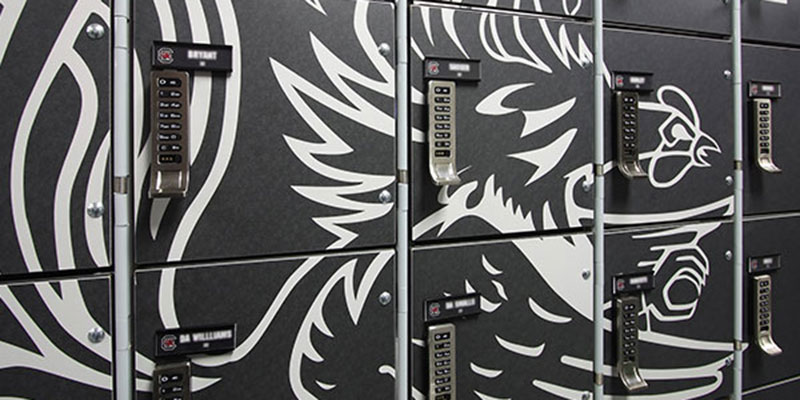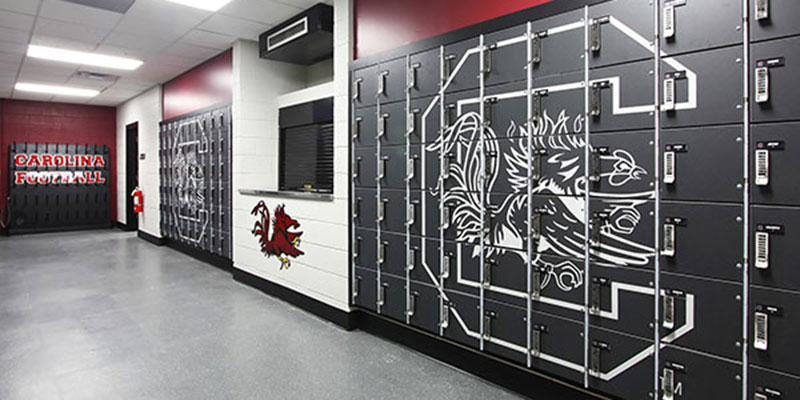Designers and facilities managers know that lockers are much more than banks of boxes.
In health club and spa settings, they provide safe spaces for clients’ belongings. Within athletic departments, like the equipment room for the University of South Carolina’s football team, locker systems play an important role in keeping equipment secure and organized.
A well-conceived locker design can increase the functionality of a space, generate revenue and improve aesthetics.
Foreman Locker Systems, a manufacturer based in Murrieta, Calif., combines high-quality American-made Compact Laminate with innovative German design to create beautiful locker systems that are hard to beat…literally. Although the company is both relatively small (18 employees) and new (manufacturing in North America since 2005), it’s signature locker systems are gaining popularity in many markets globally including: health and fitness, education, public recreation, healthcare and corporate fitness.
“We’re selling a locker based on a European design. There is nothing else like it in North America,” says Richard Shaffer, COO and director of business development for Foreman Locker Systems. “The original differentiator for this product is that it is a performance locker, super strong and super durable. But we’ve found that most people specify it because they like the European aesthetic of the design. The lines are sleek, and the surface can look like anything,including custom imaging. In application, the lockers are a finish, so the designers drive that specification.”
Marc Warren is an architect and project manager for Quackenbush Architects + Planners. His team recently completed a renovation of the University of South Carolina’s football team equipment room. The main focal point, both aesthetically and in terms of usability, is a bank of Foreman lockers featuring Wilsonart® Compact Laminate with the USC Gamecock logo. All graphics were digitally printed utilizing Wilsonart’s new custom process, Wilsonart x You.
“When we were doing our research for this project we looked at wood and High Pressure Laminate (HPL) as possibilities,” said Warren. “Then the opportunity came to look at Compact Laminate. That was the direction we decided to go for the durability and moisture resistance, but also the flexibility of design. Wilsonart gave us the ability to specify custom colors and graphics. That was a key component to the decision.”
PERFORMANCE MATERIAL
Compact Laminate, also called thick phenolic laminate, is an amazing material. Essentially, it is manufactured with the same décor paper layer and resin system as traditional HPL, but with a much thicker layer of kraft paper. After pressing, the resulting sheet is a stand-alone decorative building material that requires no substrate, adhesive system or additional finishing. Traditionally used for extremely demanding applications, like bathroom partitions, Compact Laminate, can be specified to carry any surface design (including custom graphics). “We work with Wilsonart any time we have a project with a personalized design, or when there is a short lead-time,” says Shaffer. “Wilsonart is really good when there is a rushed timeline.”
Due to its strength and design versatility, Compact Laminate is increasingly specified for a wide variety of uses, including lockers. “One advantage that my clients point out, which is particularly significant to the health and fitness industry, is the added security of Compact Laminate lockers,” says Shaffer. “Metal was the standard for a long time in rec centers and YMCAs, but health clubs don’t want the institutional look. Plus, metal lockers rust when they get wet. Solid wood is expensive and easily damaged by use and moisture. Even HPL, which is a high-performance surface, is not ideal for lockers. The decorative layer is laid up on particleboard or plywood – which is great for furniture or cabinets – but for lockers, hinges, strike plates or locking mechanisms attached to the substrate are vulnerable to security breech, so there is a high rate of door failure. Compact Laminate, which is self-supporting, is a much stronger material.”
DURABILITY AND DESIGN
Foreman Locker Systems further fortifies its products with a design that is unique to North American lockers. Borrowing from German ingenuity, Foreman products utilize an extruded aluminum framework. This interlocking system allows for adjacent lockers with side panels that are only 1mm thick, significantly reducing materials cost compared to lockers with full-box construction. In addition, the locking mechanisms attach directly to the aluminum. “This construction is so strong that it can support an integrated bench,“ says Shaffer. “Combined with the durability of the Compact Laminate, it makes a locker so secure that we warrant our products for life.”
Impenetrable lockers that are visually pleasing provide health and fitness centers with new opportunities for revenue. Sacramento based California Family Fitness is using Foreman lockers – featuring beautiful images printed using Wilsonart’s custom process – for its rental lockers. The unique Z-locker configuration with eye-catching graphics helps to differentiate the bank of lockers and make them more appealing to members.
But even lockers serving in more demanding environments, like the USC football equipment room, quietly please users simply by looking good and functioning despite the rigors of daily use. “We were looking for something that was very durable and moisture-resistant for this particular application. Compact Laminate is impervious to the high humidity associated with locker room spaces,” says Warren. “Foreman had a solution that was a good fit for us on this project. And the way their lockers are constructed, there are very few metal parts that could ultimately rust and cause problems down the road. The project turned out really nice, and everybody is very happy with the outcome.” ?








Sign In
Register